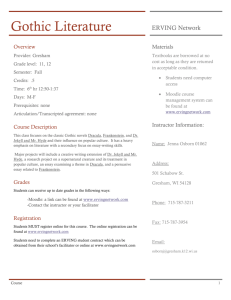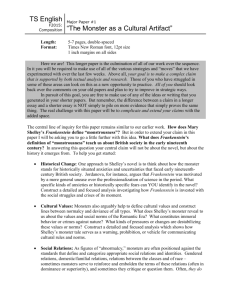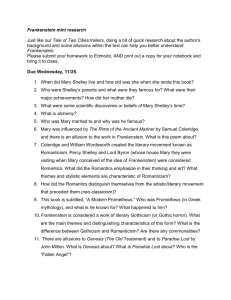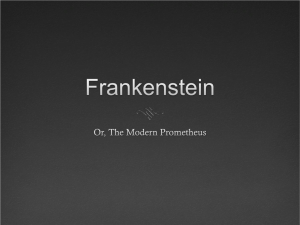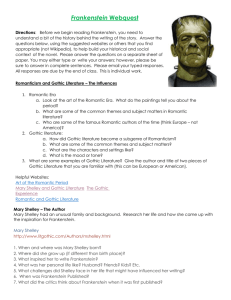FRANKENSTEIN by Mary Godwin Shelley 1 • THE OVERREACHER
advertisement
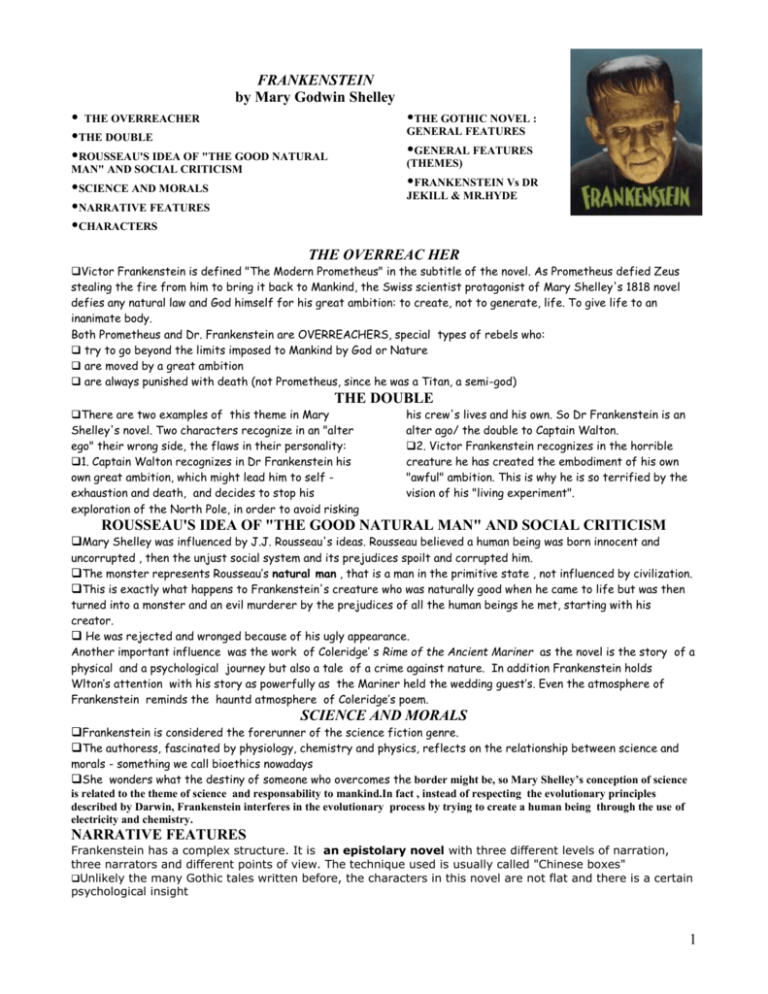
FRANKENSTEIN by Mary Godwin Shelley • THE OVERREACHER •THE DOUBLE •ROUSSEAU'S IDEA OF "THE GOOD NATURAL •THE GOTHIC NOVEL : MAN" AND SOCIAL CRITICISM •FRANKENSTEIN Vs DR GENERAL FEATURES •GENERAL FEATURES (THEMES) •SCIENCE AND MORALS •NARRATIVE FEATURES •CHARACTERS JEKILL & MR.HYDE THE OVERREAC HER Victor Frankenstein is defined "The Modern Prometheus" in the subtitle of the novel. As Prometheus defied Zeus stealing the fire from him to bring it back to Mankind, the Swiss scientist protagonist of Mary Shelley's 1818 novel defies any natural law and God himself for his great ambition: to create, not to generate, life. To give life to an inanimate body. Both Prometheus and Dr. Frankenstein are OVERREACHERS, special types of rebels who: try to go beyond the limits imposed to Mankind by God or Nature are moved by a great ambition are always punished with death (not Prometheus, since he was a Titan, a semi-god) THE DOUBLE There are two examples of this theme in Mary Shelley's novel. Two characters recognize in an "alter ego" their wrong side, the flaws in their personality: 1. Captain Walton recognizes in Dr Frankenstein his own great ambition, which might lead him to self exhaustion and death, and decides to stop his exploration of the North Pole, in order to avoid risking his crew's lives and his own. So Dr Frankenstein is an alter ago/ the double to Captain Walton. 2. Victor Frankenstein recognizes in the horrible creature he has created the embodiment of his own "awful" ambition. This is why he is so terrified by the vision of his "living experiment". ROUSSEAU'S IDEA OF "THE GOOD NATURAL MAN" AND SOCIAL CRITICISM Mary Shelley was influenced by J.J. Rousseau's ideas. Rousseau believed a human being was born innocent and uncorrupted , then the unjust social system and its prejudices spoilt and corrupted him. The monster represents Rousseau’s natural man , that is a man in the primitive state , not influenced by civilization. This is exactly what happens to Frankenstein's creature who was naturally good when he came to life but was then turned into a monster and an evil murderer by the prejudices of all the human beings he met, starting with his creator. He was rejected and wronged because of his ugly appearance. Another important influence was the work of Coleridge’ s Rime of the Ancient Mariner as the novel is the story of a physical and a psychological journey but also a tale of a crime against nature. In addition Frankenstein holds Wlton’s attention with his story as powerfully as the Mariner held the wedding guest’s. Even the atmosphere of Frankenstein reminds the hauntd atmosphere of Coleridge’s poem. SCIENCE AND MORALS Frankenstein is considered the forerunner of the science fiction genre. The authoress, fascinated by physiology, chemistry and physics, reflects on the relationship between science and morals - something we call bioethics nowadays She wonders what the destiny of someone who overcomes the border might be, so Mary Shelley’s conception of science is related to the theme of science and responsability to mankind.In fact , instead of respecting the evolutionary principles described by Darwin, Frankenstein interferes in the evolutionary process by trying to create a human being through the use of electricity and chemistry. NARRATIVE FEATURES Frankenstein has a complex structure. It is an epistolary novel with three different levels of narration, three narrators and different points of view. The technique used is usually called "Chinese boxes" Unlikely the many Gothic tales written before, the characters in this novel are not flat and there is a certain psychological insight 1 In addition, unlikely the Gothic tradition , this novel does not tell of supernatural but rather the protagonist, Victor Frankenstein , embodies the theme of science and responsibility to mankind. At first Walton informs his sister Then Frankenstein informs Walton who informs his sister; Finally the monster informs Frankenstein , who informs Walton, who informs his sister. Thus all the novel has Walton’s sister as receiver , but present three different points of view. CHARACTERS WALTON , who is the double of Dr. Frankenstein as he manifests his ambition, is characterised by Romantic element: his desire to explore the unknown ( the North Pole) ; Nature seen as the embodiment of God; His pride of being different. He tries to go beyond human limits ( Prometheus myth) and, like Prometheus, he is punished with the imprisonment of his ship in the ice and the rebellion of the crew. FRANKESTEIN and THE MONSTER are complementary: they both suffer from a sense of alienation and isolation , both of them begin with a desire to be good but they become obsessed with revenge. FRANKESTEIN may be considered Faustian overreacher who is looking for forbidden knowledge. The third part of the novel has the MONSTER as protagonist. He makes several attempts to communicate with people but he is rejected because of his ugly aspect and therefore he becomes an outcast , a murderer and a rebel against any human being. HISTORICAL BACKGROUND the distinguishing features of the Gothic novel. GENERAL FEATURES •THE GOTHIC NOVEL •The adjective “Gothic” had three important connotations: •MEDIEVAL , because it is related to the architectural style of the Middle Ages •IRREGULAR as opposed to the proportion and order of CLASSICISSM; •WILD & SUPERNATURAL in the sense of MYSTERIOUS and FEARFUL •great importance given to terrifying descriptions •ancient settings (i.e. isolated castles, secret rooms, mysterious abbeys) •the choice of Catholic countries as the setting for the most terrible crimes due to the Protestant prejudice against Catholicism •use of supernatural beings (vampires, monster, ghosts) •flat characters (the villain - a terrifying male character, often the victim of his evil impulses ; the sensitive over reactive heroine- the persecuted girl derived from the model of Richardson’s Pamela; the brave sensitive hero) •a new conception of beauty : SUBLIME GENERAL FEATURES MARY SHELLEY’s main achievement: FRANKENSTEIN, or the modern Prometheus epistolary novel use of multiple narrators (Chinese boxes) interest in science the overreacher the double social injustice Rousseau's idea of a "good natural man" 2 FRANKENSTEIN & Dr. JEKILL & MR. HYDE FRANKENSTEIN VS JEKYLL 1. THE FIGURE OF THE OVERREACHER - The two protagonists are scientists who, led by their great ambition, fulfil their achievement but, thus doing, they overcome the limits and borders imposed to them by ethics, nature or God. •Their punishment is death by exhaustion in one case, by self-destruction in the other. •Both are OVERREACHERS, rebels who go beyond the limits imposed to Mankind by God or Nature, who have their prototype in Prometheus, the mythical Titan who defied Zeus stealing the fire from the Olympus. 2. FORBIDDEN SCIENCE - Both Mary Shelley, who is considered a forerunner of science fiction, and Robert Louis Stevenson reveal deep interest in science in these works and reflect on what is now called bioethics. FRANKENSTEIN - Dr. JEKILL & MR. HYDE 3. COMPLEX NARRATIVE STRUCTURE - The two stories are told by different narrators and the reader shares different points of view. Mary Shelley's work is an epistolary novel with three narrating voices, whose narration doesn't follow a chronological sequence. It is also designed as "Chinese boxes" •Stevenson's "Jekyll and Hyde", too, has a multi - narrational structure: four different narrators and a series of different points of view are proposed to the reader: 80% of the story is told by a third - person external narrator but Enfield's, Lanyon's and Jekyll's contributions are necessary, essential, to the completeness of the puzzle Mr Utterson is trying to re-compose. FRANKENSTEIN & Dr. JEKILL & MR. HYDE 4. THE DOUBLE - In Frankenstein we can recognize two examples of these fascinating theme. Captain Walton can be considered Victor Frankenstein's "alter ego", his double, since they manifest the same ambition. Walton and Frankenstein try to go beyond human limits and are punished in the end as are all overreachers: Walton's punishment is the imprisonment in the ice and the rebellion of his crew; Frankenstein's punishment is definite, it is death. • The second example of double is Frankenstein and the creature/monster he created. Why can the latter be considered the alter ego of the first? What does Frankenstein recognize of himself in the wretched creature he brought to life? That monstrous being is the embodiment of his horrible guilty ambition, of his monstrous plan for usurping the female role and defy the basic natural laws of life. •The theme of the double in Stevenson's mystery story is based on the double identity / personality of a single human being. As Henry James said: "It deals with the relation of the baser parts of man to his nobler - of the capacity for evil that exists in the most generous nature..." FRANKENSTEIN - Dr. JEKILL & MR. HYDE 5. GOTHICISM . Gothic elements characterize both novels: the monster, exoticism, nocturnal gloomy scenes, bloody crimes, fear and terror in FRANKENSTEIN mysterious, foggy, dark setting, evil crimes, ugly devilish Mr Hyde, fear and terror in JEKYLL AND HYDE •6. RELATION TO MYTHS OF THE PAST - If Shelley's herself defined her Frankenstein a modern Prometheus, can't respectable Dr Jekyll be considered a modern Faust? •7. SOCIAL CRITICISM - Though not realistic stories meant to be social novels, they convey the attempts of their authors to criticize contemporary society as both books contain in fact critical messages in that direction. Frankenstein highlights the social injustice which transforms an innocent creature into a murderous monster by emarginating him for his ugly aspect. •Jekyll and Hyde, instead, attacks the hypocritical duplicity of the respectable Victorian society 3 4

